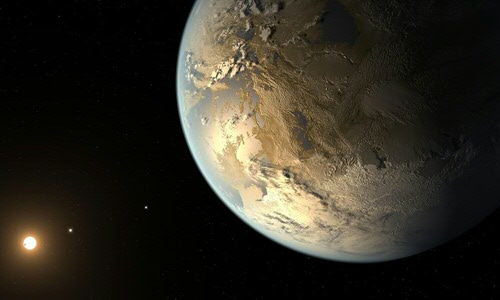New model can predict carbon cycle presence on exoplanets
Life thrives at stable temperatures. On Earth, this is facilitated by the carbon cycle. Scientists at SRON, VU and RUG have now developed a model that predicts whether there is a carbon cycle present on exoplanets, provided the mass, core size and amount of CO2 are known. Publication in Astronomy & Astrophysics on May 3rd.

In the search for life on planets outside our Solar System, astronomers don't have the luxury to take pictures and see what is going on out there. Our telescopes have nowhere near the required spatial resolution for this; exoplanets are simply too small and too far away. However, a planet's atmosphere imprints a wealth of information in the starlight that shoots through it, in the form of a spectrum. The spectral resolution of our telescopes is indeed more than enough to unravel this. That way we find out what materials are present in exoplanet atmospheres. In the search for life, CO2 is a very interesting one because of the dampening effect of the carbon cycle on warming and cooling. Thanks to this cycle, our Earth has always maintained a habitable temperature while the Sun has become 20% brighter over the past billions of years.
Scientists at SRON, VU and RUG have now developed a model that couples an exoplanet's mass and core size to the amount of CO2 in its atmosphere, provided there is a carbon cycle. So when we quantify those three factors for an exoplanet using a telescope, the model tells us if it has a carbon cycle. The mass and core size of a planet are a factor because of their strong effect on plate tectonics, which plays a key role in the carbon cycle.
The carbon cycle has a dampening influence on temperature changes because a planet absorbs more CO2 when it gets warmer, leading to less greenhouse effect.* When it gets cooler, the opposite happens. The first step in the cycle is weathering: rocks react with CO2 and rainwater to form bicarbonate (HCO3). This is deposited onto the seabed as sedimentary rock (CaCO3), while a small part of the carbon dissolves as a residual product in the seawater. Plate tectonics then transport the sedimentary rock to the Earth's mantle. Next, volcanoes release the CO2 from the sedimentary rock back into the atmosphere. 'We don't know if there are any other planets at all with plate tectonics and a carbon cycle,' says Mark Oosterloo, lead author of the paper. 'In our Solar System, the Earth is the only planet where we have found a carbon cycle. We hope that our model can contribute to the discovery of an exoplanet with a carbon cycle, and therefore possibly life.'
*This process happens much too slow to keep up with anthropogenic CO2 emissions over the past few centuries.
Publication
M. Oosterloo, D. Höning, I. E. E. Kamp, and F. F. S. van der Tak, 'The role of planetary interior in the long-term evolution of atmospheric CO2 on Earth-like exoplanets', Astronomy & Astrophysics
More news
-
11 December 2025
Stormy planets and an unexpected atmosphere
-
09 December 2025
University of Groningen Professor at COP30: ‘There is always drama’
